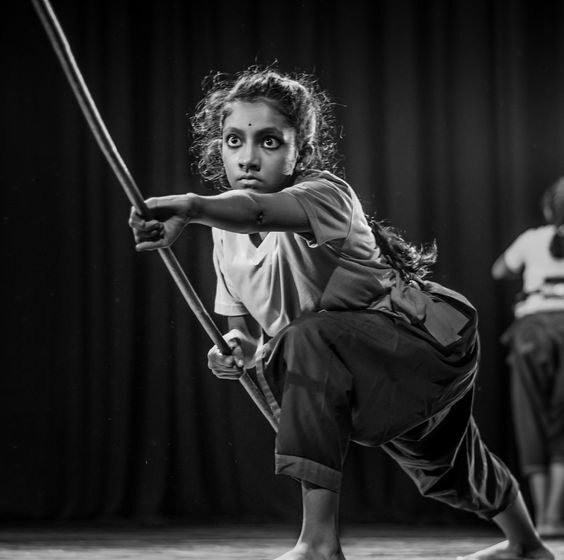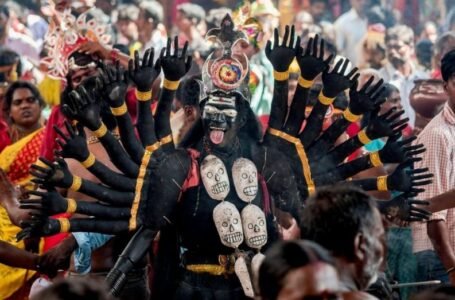KALARIPAYATTU: World’s Oldest Martial Art – said to be Invented by lord Parshuram

Kalaripayattu form of martial art belongs to Kerala and its origin dates back to 3000 years ago. If we divide the word into two, ‘Kalari’ and ‘payattu’, the word roughly translates into exercising or fighting in an arena or a gymnasium. The place where Kalaripayattu is practiced is not a typical gymnasium. Rather the centers are in a temple wherein the Kalari is built. How does it look? It is a four feet deep pit-like structure dug into the ground which is 21 feet wide and 42 feet in length.

A Kalari fighter must possess seven qualities and remind the fighters of these qualities time and again, a seven-story pyramid-like structure is built. Each step is significant in the quality that the fighter must possess. In the southwest corner of the arena lies the poothara which is a space reserved for the guardian deity of Kalari. Kalaripayattu is not a combat form limited to hand-to-hand combat. The use of weapons such as knives, shields, daggers, spears, etc is prominent and plays a very important role.

As mentioned before, the art form dates back to the 3rd century BC. It is one of the oldest, forms of martial arts to exist in the world. It was a raw format using which animals were hunted on the rocky terrains of Kerala before it transformed into a combat technique. It is to be believed that the sixth incarnation of Vishnu, Parasuram, was the one who gave origin to Kalaripayattu. Parasuram gave rise to 42 Kalaris in total which was taught among twenty-one masters. The masters were known as Kuruppu or Gurukkal. These masters of the specific Kalaris were meant to protect the land of Kerala. The martial art form was taught to the warrior class as they were the ones on whose shoulders the responsibility of protecting the land lay. The warfare technique was used extensively during the period when the Pandyas, Cholas, and Chera dynasties fought for a duration of around 100 years. If we see historical references made to this form of martial art, it was never limited to the males of the society, and women warriors have also been talked about as well.

There are three schools in Kalaripayattu and three training phases as well. The three schools go by the name of Vaddakan Kalari, Thekkan Kalari, and Thulundan Kalari. These forms are divided on the basis of geographical boundaries. Where Vaddakan Kalari belongs or rather is prevalent in the Northern region of Kerala, the latter are prevalent in Southern Kerala and Kanyakumari, and the northernmost part of Kerala and Canara region of Karnataka. Vaddakan Kalari is said to be the form propagated by Parasuram and is considered the original form of Kalaripayattu. The main focus in this form is on physical combat and fast bodily reflexes. The term used for it is ‘Meyyu Kannakanam’. It translates to the body being like an eye. The reflexes of one should be as fast as the eye. The moment our eyes identify a threat they close, in the same manner, one’s body should have lightning-fast responses. Thekkan Kalari’s founder is supposed to be Agastya the saint. The form has a lot of influence from other martial art forms such as Silambattam and Adi Murai. These two forms were found in Tamil Nadu and that is one of the main reasons that Thekkan Kalari is more famous in Tamil Nadu. Thulundan Kalari is a less practiced style and not much is known about it.

The training in Kalaripayattu is divided into three parts- Meythari, Kolthari, and Angathari. Just as the sequence of mentions, they are the levels of advancement. Meythari is the first stage wherein a set of exercises are performed that help in improving the strength of the body, stamina, and flexibility as these are traits that are better built upon and improved in the early stages of life, children at the age of seven to eight start practicing this form. The moment their master feels that the student has achieved the level required, he or she gets promoted to learning new skills such as locking and combating without weapons, jumping (chattam), summersault (marichil), and running(ottam).
Once all these forms are perfected, the student is promoted to using wooden weapons also known as Kol. This training stage acts as a precursor to the next stage which is Angathari. Herein, the students get a hold of how to use real weapons such as the sword (Urumi), spear (Kuntham), stick (Vadi), and dagger(Kathi).

Just like any other art form, Kalaripayattu suffered at the hands of the British Raj as well. Although it is one of the oldest forms to be practiced till now there was a time when its practice was banned. The reason was simple this form of combat would give rise to those who stand and fight against the British. The combat form suffered with time but the British were not able to eradicate it as a few of those who practiced the martial arts were still left and they made sure that it was passed on to the coming generations, secretly. Flash forward to modern times, and one of the most famous practitioners is Meenakshi Raghavan also known as Meenakshi Amma. She started training at a young age and is now a master of the sword and the shield. She fights against men and women half her age and defeats them very easily. The female fighter runs a school with over a hundred students, making sure that a generation does not miss out on this incredible art form.

It may be thought that this martial art form is boring form as compared to Boxing, Myu-Thai, and Kickboxing and not many would pick it up. This stands to be not true as Bollywood actors such as Ranbir Kapoor, Vidyut Jamwal, Jacqueline Fernandez, Parineeti Chopra, and Sanya Malhotra are not only its practitioners but endorsers as well.
If one wants to measure the impact of the art form, then one should observe the classical dance forms. Kolkali and Kathakali are the two dance forms that are greatly influenced by Kalaripayattu. Another aspect of Kalaripayattu used in the dance forms is the Kalari massage or the Uzhichil. It helps in relieving pain, increasing blood circulation as well as in detoxification the body. Uzhichil helps in improving the flexibility and agility of the body and curing neurological, ligamental, and muscular ailments.
There are many organizations that are currently working to promote Kalaripayattu internationally by conducting classes and workshops. A cartoon series made by Cartoon Network named Little Kalari Warriors had the series revolving around Kalaripayattu practitioners. In recent times, an anime character of Indian origin was introduced in a Japanese Manga named Agari. The character named Ravi is also shown to be a Kalaripayattu master. Not only the fictional world but also a documentary titled The Way of the Warrior has also been made on the martial art form of Kalaripayattu. The famous video game, Tekken, also has a character named Zafina who happens to be a practitioner of the form. There are countless movies in which this form has been used as a form of self-defense. It has been used in movies since the early 70s till now.

The impact and importance of this art form can be measured by the fact that it has been included in the Khelo India Youth Games. It stands tall alongside other martial art forms such as Gatka and Thang-Ta to be included in the sports event. This has not only put the indigenous sport on the map but has also made it easy for the practitioners to preserve it. Because the art form could not have been performed for about a hundred years openly during the British Raj, it is very important to revive it on a large scale. There are a lot of benefits to practicing Kalaripayattu. Not only does it improve the strength and flexibility of an individual but also helps to fight and protect oneself. In this time and age, where the crime rate is always on the rise irrespective of the time of the day and the location where you are, it is very important to know how to defend yourself. Being physically fit also positively affects one’s concentration levels as well as improving patience. The immunity of the body gets enhanced which decreases the risk of getting sick and makes life easier. The art form is not like going to the gym which means that you exercise on the same machines every day. The art form in itself is so versatile that there will always be something new to learn whether in hand-to-hand combat or weapons training. As you practice with other fighters, it also develops the trait of sportsmanship in an individual and helps in developing the patience and flexibility required to work in a group.


